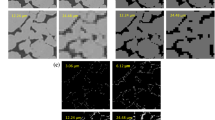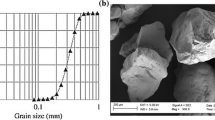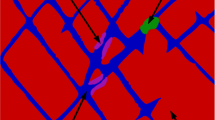Abstract
X-ray micro-computed tomography (\(\mu\)CT) can produce realistic 3D-images of the pore structure of a material. Extracting its geometry enables the computation of effective properties of the material—such as the permeability (k) and the hydrodynamic dispersion coefficient (\(D_h\))—, through the solutions of the Stokes equation (SE) and Advection-Diffusion equation (ADE), respectively. In this study, the effect of the image resolution on these properties is discussed. For such purpose, four different resolutions are evaluated for both a real sample of Fontainebleau sand and a numerically generated sample created by degrading the Fontainebleau image with highest resolution. The SE was computed using the commercial software GeoDict. To solve the ADE, a Finite Volume software was developed which includes a high order total variation diminishing scheme for advection. The analysis of dispersion was based on numerical breakthrough curves. Our model was tested in a large range of Peclet numbers (Pe) and travel distances, accurately describing the transition between diffusion and advection dominated regimes of dispersion. The \(D_h\) exhibits a linear increase with travel distance for Pe \(> 10\). This classical effect increases with increasing Pe. The percentage change on k and \(D_h\) increases with decreasing resolution in agreement with the corresponding behavior of porosity, specific surface and pore size distributions. The images directly scaled with the \(\mu\)CT showed more discrepancy than the numerically scaled images. The criteria to estimate the quality of permeability from the pore size distribution proposed on our previous study remains valid. The \(D_h\) is less sensitive to resolution than k.









Similar content being viewed by others
Notes
Rescaling or resizing is the process of increasing or decreasing the number of pixels in an image or voxels in a volume. This process is not lossless. Rescaling a volume to a smaller number of voxels, and then rescaling it back to the original resolution, results in an image sightly different from the original one (Danahy et al. 2007).
PV is the time required for the concentration to completely fill the porous volume under study.
The CXTFIT software has the option to compute the BTC given the effective coefficients of a column experiment (direct problem).
Abbreviations
- BTC:
-
Break thought curve
- \(D_x\) :
-
x percentage of pores that have a diameter \(D_x\)
- \(d_x\) :
-
x percentage of grains that have a diameter \(d_x\)
- FDM:
-
Finite difference method
- FEM:
-
Finite elements method
- FVM:
-
Finite volume method
- LBM:
-
Lattice Boltzmann method
- macro ADE:
-
Advection dispersion equation at macro scale
- micro ADE:
-
Advection diffusion equation at micro scale
- \(\mu\)CT:
-
Micro computed tomography
- MUMPS:
-
MUltifrontal massively parallel solver
- PEEK:
-
PolyEtherEtherKetone
- PSD:
-
Pore size distribution
- RF:
-
Rescaling factor
- SPH:
-
Smooth particle hydrodynamics
- TVD:
-
Total variation diminishing
- VOI:
-
Volume of interest
References
Al-Raoush, R., Papadopoulos, A.: Representative elementary volume analysis of porous media using x-ray computed tomography. Powder Technol. 200(1–2), 69–77 (2010)
Al-Raoush, R., Willson, C.: Extraction of physically realistic pore network properties from three-dimensional synchrotron x-ray microtomography images of unconsolidated porous media systems. J. Hydrol. 300(1–4): 44–64 (2005). https://doi.org/10.1016/j.jhydrol.2004.05.005. http://www.sciencedirect.com/science/article/pii/S0022169404002355
Alhashmi, Z., Blunt, M., Bijeljic, B.: Predictions of dynamic changes in reaction rates as a consequence of incomplete mixing using pore scale reactive transport modeling on images of porous media. J. Contam. Hydrol. 179, 171–181 (2015)
Amestoy, P.R., Duff, I.S., L’Excellent, J.Y.: Mumps multifrontal massively parallel solver version 2.0. Technical report TR/PA/98/02, 1–51 (1998)
Auriault, J.L., Boutin, C., Geindreau, C.: Homogenization of coupled phenomena in heterogenous media, vol. 149. Wiley, New York (2010)
Barkouki, T., Martinez, B., Mortensen, B., Weathers, T., De Jong, J., Ginn, T., Spycher, N., Smith, R., Fujita, Y.: Forward and inverse bio-geochemical modeling of microbially induced calcite precipitation in half-meter column experiments. Transp. Porous Media 90(1), 23 (2011)
Bear, J.: Dynamics of fluids in porous media. Dynamics of Fluids in Porous Media, vol 1. American Elsevier Publishing Company, New York (1972)
Bear, J.: Modeling Phenomena of Flow and Transport in Porous Media, vol. 31. Springer, Berlin (2018)
Bijeljic, B., Raeini, A., Mostaghimi, P., Blunt, M.J.: Predictions of non-fickian solute transport in different classes of porous media using direct simulation on pore-scale images. Phys. Rev. E 87(1), 013011 (2013)
Bruining, H., Darwish, M., Rijnks, A.: Computation of the longitudinal and transverse dispersion coefficient in an adsorbing porous medium using homogenization. Transp. Porous Media 91(3), 833–859 (2012)
Brusseau, M.L.: The influence of solute size, pore water velocity, and intraparticle porosity on solute dispersion and transport in soil. Water Resourc. Res. 29(4), 1071–1080 (1993)
Bultreys, T., De Boever, W., Cnudde, V.: Imaging and image-based fluid transport modeling at the pore scale in geological materials: a practical introduction to the current state-of-the-art. Earth-Sci. Rev. 155, 93–128 (2016)
Cooper, D., Turinsky, A., Sensen, C., Hallgrimsson, B.: Effect of voxel size on 3d micro-ct analysis of cortical bone porosity. Calcif. Tissue Int. 80(3), 211–219 (2007)
Csomós, P., Faragó, I., Havasi, Á.: Weighted sequential splittings and their analysis. Comput. Math. Appl. 50(7), 1017–1031 (2005)
Dadda, A., Geindreau, C., Emeriault, F., Du Roscoat, S.R., Garandet, A., Sapin, L., Filet, A.E.: Characterization of microstructural and physical properties changes in biocemented sand using 3d x-ray microtomography. Acta Geotech. 12(5), 955–970 (2017)
Dal Ferro, N., Strozzi, A., Duwig, C., Delmas, P., Charrier, P., Morari, F.: Application of smoothed particle hydrodynamics (sph) and pore morphologic model to predict saturated water conductivity from x-ray ct imaging in a silty loam cambisol. Geoderma 255, 27–34 (2015)
Danahy, E.E., Agaian, S.S., Panetta, K.A.: Algorithms for the resizing of binary and grayscale images using a logical transform. In: Electronic Imaging 2007, pp. 64970Z–64970Z. International Society for Optics and Photonics (2007)
Dubois, F.: Nonlinear interpolation and total variation diminishing schemes. arXiv preprint arXiv:1006.3921 (2010)
Feia, S., Dupla, J.C., Ghabezloo, S., Sulem, J., Canou, J., Onaisi, A., Lescanne, H., Aubry, E.: Experimental investigation of particle suspension injection and permeability impairment in porous media. Geomech. Energy Environ. 3, 24–39 (2015)
Feia, S., Sulem, J., Canou, J., Ghabezloo, S., Clain, X.: Changes in permeability of sand during triaxial loading: effect of fine particles production. Acta Geotech. 11(1), 1–19 (2016)
Guibert, R., Nazarova, M., Horgue, P., Hamon, G., Creux, P., Debenest, G.: Computational permeability determination from pore-scale imaging: sample size, mesh and method sensitivities. Transp. Porous Media 107(3), 641–656 (2015). https://doi.org/10.1007/s11242-015-0458-0
Jiang, F., Tsuji, T.: Changes in pore geometry and relative permeability caused by carbonate precipitation in porous media. Phys. Rev. E 90(5), 053306 (2014)
Keesstra, S.D., Geissen, V., Mosse, K., Piiranen, S., Scudiero, E., Leistra, M., van Schaik, L.: Soil as a filter for groundwater quality. Curr. Opin. Environ. Sustain. 4(5), 507–516 (2012)
Khan, F., Enzmann, F., Kersten, M., Wiegmann, A., Steiner, K.: 3d simulation of the permeability tensor in a soil aggregate on basis of nanotomographic imaging and lbe solver. J. Soils Sediments 12(1), 86–96 (2012)
Klotz, D., Moser, H.: Hydrodynamic dispersion as aquifer characteristic: Model experiments with radioactive tracers. In: Isotope techniques in groundwater hydrology 1974, Vol. II. Proceedings of a symposium (1974)
Lehmann, G., Legland, D.: Efficient n-dimensional surface estimation using crofton formula and run-length encoding. Insight J. 2, 1–11 (2012)
Lehmann, P., Wyss, P., Flisch, A., Lehmann, E., Vontobel, P., Krafczyk, M., Kaestner, A., Beckmann, F., Gygi, A., Flühler, H.: Tomographical imaging and mathematical description of porous media used for the prediction of fluid distribution. Vadose Zone J. 5(1), 80–97 (2006)
Mohammadmoradi, P., Taheri, S., Bryant, S.L., Kantzas, A.: Solvent diffusion and dispersion in partially saturated porous media: an experimental and numerical pore-level study. Chem. Eng. Sci. 191, 300–317 (2018)
Muñoz-Ortega, F.J., Martínez, F.S.J., Monreal, F.C.: Volume, surface, connectivity and size distribution of soil pore space in ct images: comparison of samples at different depths from nearby natural and tillage areas. Pure Appl. Geophys. 172(1), 167–179 (2015)
Ortega Ramírez, M.P., Oxarango, L., Gastelum Strozzi, A.: Effect of x-ray ct resolution on the quality of permeability computation for granular soils: definition of a criterion based on morphological properties. Soil Res. 57(6), 589–600 (2019)
Ovaysi, S., Piri, M.: Pore-scale modeling of dispersion in disordered porous media. J. Contam. Hydrol. 124(1–4), 68–81 (2011)
Passioura, J., Rose, D.: Hydrodynamic dispersion in aggregated media: 2. Effects of velocity and aggregate size. Soil Sci. 111(6), 345–351 (1971)
Pickens, J.F., Grisak, G.E.: Scale-dependent dispersion in a stratified granular aquifer. Water Resour. Res. 17(4), 1191–1211 (1981)
Puckett, L.J., Hughes, W.B.: Transport and fate of nitrate and pesticides. J. Environ. Qual. 34(6), 2278–2292 (2005)
Ridler, T., Calvard, S., et al.: Picture thresholding using an iterative selection method. IEEE Trans. Syst. Man Cybern. 8(8), 630–632 (1978)
Rutka, V.: A staggered grid-based explicit jump immersed interface method for two-dimensional stokes flows. Int. J. Numer. Methods Fluids 57(10), 1527–1543 (2008)
Saffman, P.: Dispersion due to molecular diffusion and macroscopic mixing in flow through a network of capillaries. J. Fluid Mech. 7(2), 194–208 (1960)
Shah, S., Gray, F., Crawshaw, J., Boek, E.: Micro-computed tomography pore-scale study of flow in porous media: effect of voxel resolution. Adv. Water Resour. 95, 276–287 (2016)
Smaoui, H., Zouhri, L., Ouahsine, A.: Flux-limiting techniques for simulation of pollutant transport in porous media: application to groundwater management. Math. Comput. Modell. 47(1–2), 47–59 (2008)
Toride, N., Leij, F., Van Genuchten, M.T., et al.: The cxtfit code for estimating transport parameters from laboratory or field tracer experiments. Technical Report, version 2.0, Research Report (1995)
Vanclooster, M., Boesten, J., Tiktak, A., Jarvis, N., Kroes, J., Muñoz-Carpena, R., Clothier, R., Green, S.: On the use of unsaturated flow and transport models in nutrient and pesticide management. Frontis 2005, 331–361 (2005)
Wanner, C., Zink, S., Eggenberger, U., Mäder, U.: Assessing the cr (vi) reduction efficiency of a permeable reactive barrier using cr isotope measurements and 2d reactive transport modeling. J. Contam. Hydrol. 131(1–4), 54–63 (2012)
Weber, A., Ruhl, A.S., Amos, R.T.: Investigating dominant processes in ZVI permeable reactive barriers using reactive transport modeling. J. Contam. Hydrol. 151, 68–82 (2013)
Whitaker, S.: The method of volume averaging, vol. 13. Springer, Berlin (2013)
Wiegmann, A.: Computation of the permeability of porous materials from their microstructure by fff-stokes. Bericht des Fraunhofer ITWM (2007)
Wiegmann, A., Bube, K.P.: The explicit-jump immersed interface method: finite difference methods for PDES with piecewise smooth solutions. SIAM J. Numer. Anal. 37(3), 827–862 (2000)
Yang, X., Mehmani, Y., Perkins, W.A., Pasquali, A., Schönherr, M., Kim, K., Perego, M., Parks, M.L., Trask, N., Balhoff, M.T., Richmond, M.C., Geier, M., Krafczyk, M., Luo, L.S., Tartakovsky, A.M., Scheibe, T.D.: Intercomparison of 3d pore-scale flow and solute transport simulation methods. Adv. Water Resour. 95, 176–189 (2016)
Zaretskiy, Y., Geiger, S., Sorbie, K., Förster, M.: Efficient flow and transport simulations in reconstructed 3d pore geometries. Adv. Water Resour. 33(12), 1508–1516 (2010)
Acknowledgements
We are grateful to Dr. D.A. Amor-Quiroz for helping us with proofreading the present manuscript and making the content clearer. Permeability computations were performed using the FlowDict module of the GeoDict software package.
Funding
This study was supported by the PROTINUS project funded in the framework of the European Union’s Horizon 2020 research. It benefited from a PhD Grant from the CONACYT Reference no.240912/383935, and a grand concerning the access to the X-ray Thomograph from Labex OSUG@2020 (Investissements d’Avenir-ANR-10-LABX-0056).
Author information
Authors and Affiliations
Corresponding author
Ethics declarations
Conflict of interest
The authors declare that they have no conflict of interest.
Additional information
Publisher's Note
Springer Nature remains neutral with regard to jurisdictional claims in published maps and institutional affiliations.
Rights and permissions
About this article
Cite this article
Ortega-Ramírez, M.P., Oxarango, L. Effect of X-ray \(\mu\)CT Resolution on the Computation of Permeability and Dispersion Coefficient for Granular Soils. Transp Porous Med 137, 307–326 (2021). https://doi.org/10.1007/s11242-021-01557-7
Received:
Accepted:
Published:
Issue Date:
DOI: https://doi.org/10.1007/s11242-021-01557-7




